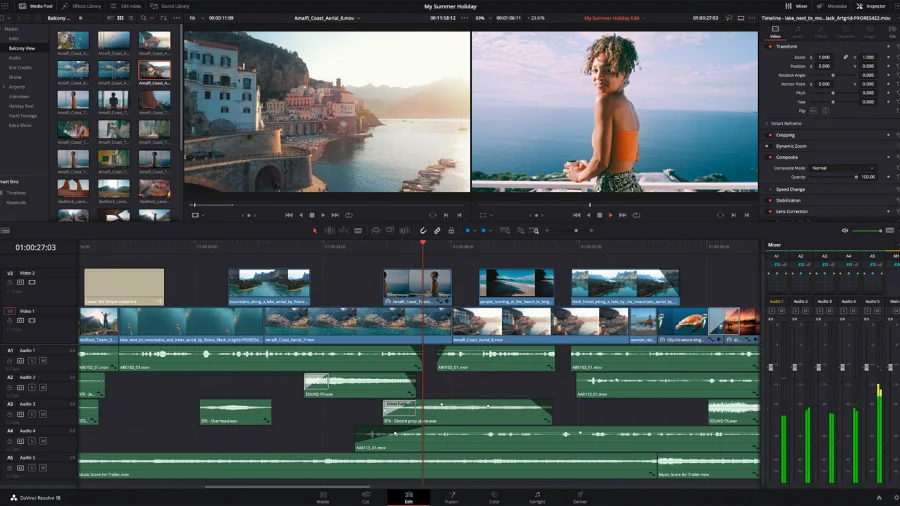We dive into our top 5 technological advancements set to change the video production landscape forever.
Video production has come a long way over the years, and technological advancements have continually elevated the quality and reach of visual storytelling.
As we approach 2024, exciting developments that promise to transform the video production landscape are on the horizon. Let’s look at the technological advances that will make the upcoming year an exhilarating time for video production.
#1: 8K Resolution Becomes Mainstream

While 4K resolution has become increasingly prevalent in recent years, 2024 will likely witness the mainstream adoption of 8K resolution. This leap in resolution will enable video producers to capture stunning details, delivering an immersive and visually captivating experience to viewers. Increasing resolution will also provide more flexibility during the editing process, allowing for greater flexibility in cropping and zooming without compromising quality.
#2: AI-powered Automated Editing

Artificial Intelligence (AI) is making rapid strides in various industries, and the world of video production is no exception. 2024, we anticipate integrating AI-powered automated editing tools to streamline and expedite the post-production process. With advanced algorithms and machine learning, these tools will help sort and select the best shots, enhance transitions, and even assist in colour grading. As a result, video editors will have more time to focus on creative decision-making, leading to faster turnarounds and improved efficiency.
#3: Real-time Collaboration and Cloud-Based Integration

Collaboration is a vital aspect of video production, and in 2024, technological advances will facilitate real-time teamwork regardless of geographical boundaries. Cloud-based integration platforms will enable seamless collaboration between team members, allowing them to work on the same project simultaneously. This capability will enhance productivity, enabling instant feedback and accelerated project delivery.
#4: Virtual Production for Enhanced Creative Control

Once reserved for big-budget Hollywood productions, virtual production techniques will become more accessible and affordable in 2024. These techniques use real-time rendering and virtual environments to create realistic backgrounds and settings. With virtual production, video creators will have greater creative control, enabling them to experiment with different scenes, effects, and lighting conditions. This advancement will revolutionise storytelling, immersing audiences in new captivating narratives.
#5: Enhanced Streaming and Distribution Platforms

In 2024, video production will be further propelled by advancements in streaming and distribution platforms. As internet speeds improve, 5G networks will become more widespread, providing faster and more reliable streaming experiences. This will lead to increased video content consumption on various platforms, presenting video producers with a larger and more engaged audience.
Conclusion:
In conclusion, 2024 holds immense promise for video production, with groundbreaking technologies poised to reshape the industry. From the adoption of 8K resolution and AI-powered editing tools to real-time collaboration and virtual production techniques, the future of video production is filled with immense potential.
Embracing these technological advances will allow video creators to unleash their creativity, deliver captivating stories, and connect with audiences on a deeper level. Get ready to be amazed as the year 2024 unfolds, bringing us ever closer to the future of video production
Honourable Mention: Virtual Reality (VR)

With Apple’s new ‘Apple Vision Pro’ and Meta Quest, could VR make considerable leaps forward in 2024 for video production? While VR has significantly progressed, it hasn’t yet achieved mainstream adoption.VR has the potential to deliver unparalleled immersive experiences, captivating viewers by transporting them to virtual worlds. In video production, VR can offer an innovative way of storytelling, allowing audiences to step inside the narrative and become active participants. While the potential for VR in video production is exciting, several challenges still need to be addressed for widespread adoption. Firstly, there is the issue of cost. VR equipment and production tools can be expensive, making them less accessible to smaller production teams and independent creators.
Additionally, creating content that takes full advantage of the VR medium is challenging. Crafting compelling narratives and ensuring that the experience justifies the use of VR requires a different approach than traditional video production. While VR has its merits, there is also the possibility that Augmented Reality (AR) may gain more traction in video production than VR by 2024. Unlike VR, AR does not require users to be fully immersed in a virtual environment. Instead, it overlays digital content in the real world, offering a more flexible and accessible experience. With AR, video producers can enhance storytelling by integrating digital elements into the physical world, offering a blend of the real and virtual.
In conclusion, while VR holds great potential for video production, its prominence in 2024 is still being determined. VR may succeed in niche applications and specific industries, but challenges remain, including cost and content creation. The rise of AR and evolving consumer preferences could also impact VR’s dominance. Regardless, it is clear that immersive technologies will continue to shape the future of video production, and both VR and AR have significant roles to play in this evolution, but not just yet, in our opinion.






